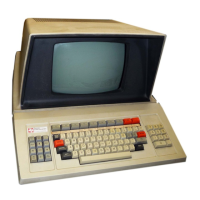~-------
~
945424-9701
1.4 PRINCIPLES
OF
OPERATION
The following paragraphs provide detailed descriptions
of
the operation
of
the various circuitry
of
the Model 911 VDT subsystem. Figure 1-16
is
the detailed block diagram
that
provides the
basis for the remainder
of
this section's discussion. Discussions
of
specific circuitry are augmented
with more detailed circuit diagrams, flowcharts, and timing diagrams
as
needed for the discussion.
1.4.1 KEYBOARD. United States, European, and Japanese keyboard operation
is
discussed. Key-
board encoding
is
accomplished by one
of
two methods:
• Diode-isolated mechanical keyswitches with L52 encoder and scanner
• Solid-state keyswitches with microprocessor scanner and encoder.
Japanese Katakana keyboards will be vendor-supplied with solid-state keyswitches. The keyboard
assembly logic diagram and contact matrix description are provided in Appendix F. Figure 1-17
is
a block diagram
of
the diode-isolated mechanical keyboard used in United States and European
keyboard versions; paragraphs 1.4.1.1, 1.4.1.2, and 1.4.1.3 provide detailed discussions
of
the
keyboard's circuitry. United States keyboards will be supplied with
both
encoding techniques.
1.4.1.1 Contact Matrix. The contact matrix for the keyswitches consists
of
two sets
of
scan
lines, each in a different plane, that run behind the keyswitches in such a manner
that
each time a
keyswitch
is
actuated, the switch closes a circuit between an X and a Y scan line with the key-
switch and a diode, forming a series circuit between the scan lines. Figure 1-18 illustrates the United
States and European contact matrix and a typical keyswitch circuit. Figure 1-19 shows the United
States keyboard with each key numbered, and table i-4 identifies the matrix connections and
diodes involved in each keyswitch closure. Japanese Katakana contact matrix information
is
illustrated in Appendix F.
1.4.1.2 Encoder. The encoder
is
a four-mode programmable encoder
that
performs the following
functions:
• Produces a unique eight-bit parallel
da1
! code for each combination
of
signals
input
to
its
X,
Y,
Shift, and Control inputs
• Produces a 20-microsecond (nominal) strobe pulse for each new eight-bit parallel code
• Produces a new eight-bit code and strobe pulse for each key struck regardless
of
any keys
being held
do·w:··.
Table
1-5
lists the codes produced by the encoder for each key in each mode and relates the infor-
mation to figure 1-19. Appendixes A through F contain the codes produced by the national key-
boards available with the Model 911 VDT. The key legends and codes are those
not
shown in table
1-5, and the information
is
related
to
numbered keyboard illustrations similar to figure 1-19.
1.4.1.3 Mode Keys and Mode Select Logic. The SHIFT, CONTROL, UPPER CASE LOCK, and
REPEAT keys with the mode select logic shown in figure 1-20 determine the code produced by
the keyboard encoder and whether or
not
that
code
is
repeatedly transmitted to the computer.
There are two SHIFT keys. They are wired in parallel and perform the same function.
Each
of
the
five
mude keys closes a single set
of
contacts when actuated. These contacts, except
for the REPEAT
key~
are decoded
to
select the keyboard encoder mode, and are
not
connected
to
the contact matrix. One side
of
each mode keyswitch
is
grounded, and the other side (used
to
provide
an
input to rnode select logic)
is
connected to
+5
Vdc
via
a pullup resistor. The pullup
resistor guarantees
that
the keyswitch's
output
to
mode select logic
is
held high until the
keyswitch
is
closed,
at
which time the line
is
grounded.
1-23
Digital Systems Division

